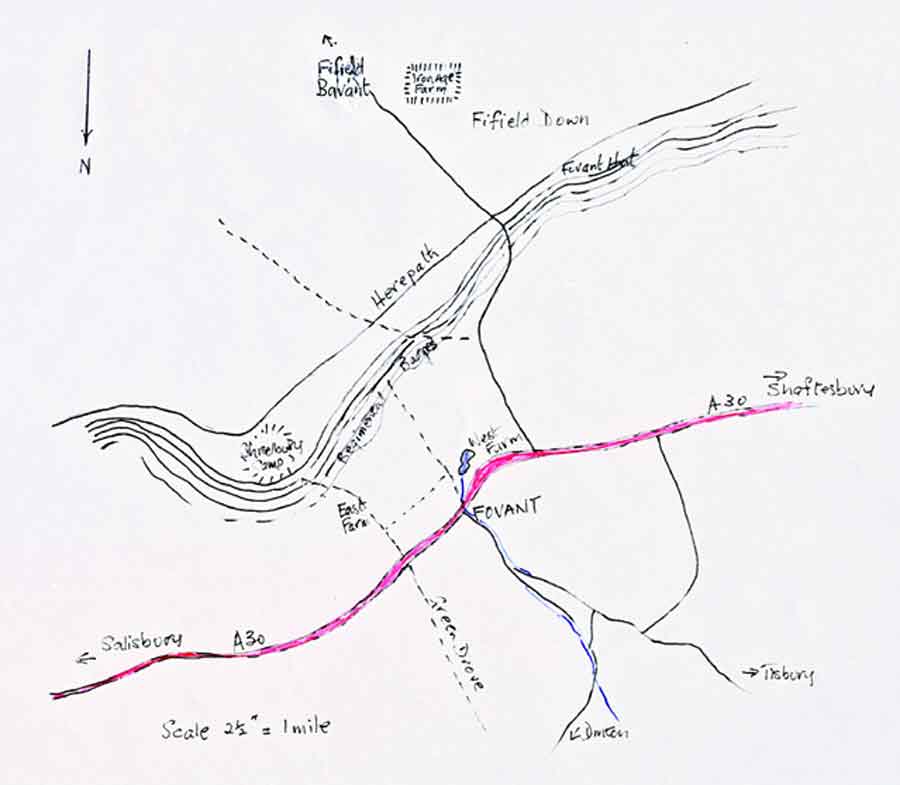
Group Settlement as farming developed
There is some suggestion that there was a Bronze Age settlement on Fir Hill in Fovant and another at Swallowcliffe, but there is no indication on the ground of any habitation at either site, so their existence must be a matter of conjecture until further research proves differently. What is not in doubt is that there was a large Early Iron Age settlement, dated to around 400–300 BC, at Fifield Ashes, which is approximately half a mile south of Fovant Hut.

Although this village was just outside the current Fovant Parish boundary obviously no such divisions existed then, so this particular settlement is of importance in the context of Fovant prehistory.
Discovered, and subsequently excavated, in 1923 by our late doctor, R.C.C. Clay, he subsequently published his findings in the June 1924 edition of the Wiltshire Archaeological and Natural Magazine, from which the information concerning the Fifield settlement is taken.
An Iron Age village at Fifield Ashes.
This extensive settlement, dated to around 400–300 BC, contained a mixture of dwelling and storage structures. The roof of such a building, having no central pole, resembled a truncated cone. Its construction consisted of boughs of birch or hazel laid with the larger ends meeting and bound in the centre, which were then crossed with other sticks. This framework, after being filled with a daub of clay, chalk and occasional flint, was thatched with layers of grass and straw. It is a matter of conjecture as to what the inside looked like, but excellent replicas of such dwellings may be seen at Butser Ancient Farm , near Petersfield in Hampshire.
The evidence gathered from within the remains of the numerous dwelling and storage pits suggests an Iron Age settlement, not only of considerable size but one whose inhabitants had many comparatively sophisticated skills. These people were settled farmers who practised a mixed farming economy and would also have traded beyond their borders to some extent.

The sketch on the left, by Alan Sorrell (click to enlarge) is imaginary, but as it is based on historical research, it gives some idea of what life was like during the Iron Age.
The range of artefacts and materials uncovered at Fifield included:
Cereals – barley, wheat and oats
Chalk – spindle whorls, sling bullets
Stone – grinding querns, loom weights, tools, whetstone, weapons and floor paving. (quarried from Chilmark, Teffont and Fovant)
Sandstone – an anvil (stone brought from Westbury specifically for smelting)
Iron – linchpin for wheel axle, shears, knives, sickle, hinged brooch, ring-handled pin, a chain link, a clamp, and a great deal of iron slag in what is thought to have been a blacksmith’s area.
Clay – innumerable shards of pottery – some made of local material, but others were from pots which must have been traded from further a field.
Bone – of oxen, sheep, horses, pigs, goats and dogs providing material for the manufacture of spindle whorls, perforated needles, awls, spatulas and combs.
Very few human remains were found in any of the pits, although Doctor Clay discovered a single burial of this period at the western end of nearby Chiselbury Camp, the Iron Age hill fort on the downs above Fovant. He excavated at this site and reported on his findings in the June 1928 edition of the Wiltshire Archaeological and Natural History Magazine.
Chiselbury Camp. ‘It had a single vallium and ditch with an outwork and entrance to the south-east. The area within the ramparts contains 10 acres …and the height of the vallium is 11 feet’ Colt Hoare – History of Ancient Wilts. Vol. 1.
As the prehistoric population increased, inevitably the pressure on land increased and local strongholds became necessary. During the Iron Age small circular defensive structures such as Chiselbury Camp were built. Whether Chiselbury was constructed by the inhabitants of the Fifield settlement is unknown, but it is of the same period so it seems highly likely that they did so.
J.O.H.
January 2006


